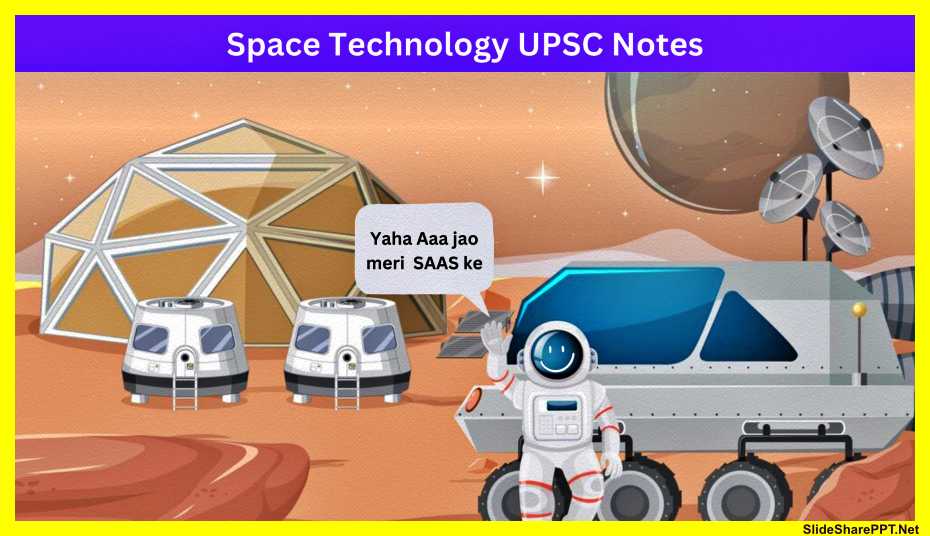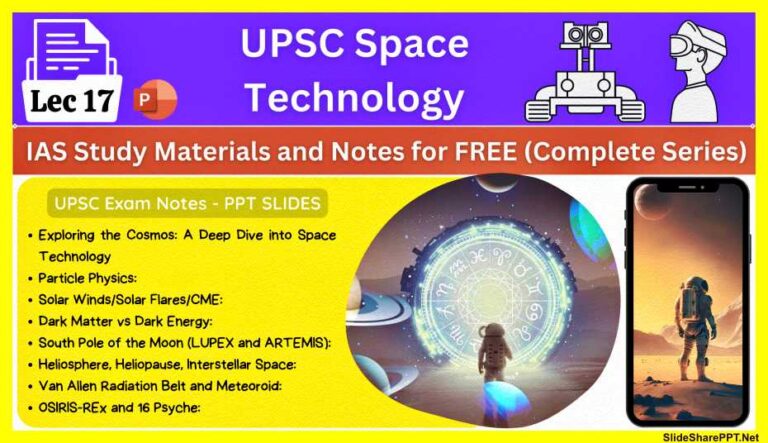UPSC Space Technology
Today we have shared Notes related to UPSC Space Technology, you can download this page as a PDF and a PPT with 1 Click, So these Notes Help you a lot, Read them, and move forward in life.
- Space, the boundless expanse that stretches beyond our earthly confines, has always held an irresistible allure for humankind. Space technology, a testament to human ingenuity and scientific exploration, has played a pivotal role in transforming our understanding of the cosmos. From probing distant galaxies to studying fundamental particles, space technology has become the cornerstone of modern astrophysics and space exploration. This article embarks on a journey to explore the marvels of space technology, delving into its various facets and the groundbreaking achievements that have shaped our cosmic odyssey.
UPSC Space Technology – (PPT Lec 17)
Important:-
- If you are viewing this PPT on your phone, please make it full screen and then view it. (Press: 3 dots in PPT, then Full Screen)
- If you have a problem while clicking on next, (Just tap) on the slide instead of clicking Next Botton.
- FOR A BETTER VIEW PRESS Ctrl + Shift + F ON A PC OR LAPTOP.
- Whatever is written in the PPT is different and whatever is written below is different.
- ONE MORE THING – You can read these notes in your Language by pressing the translation button (see Upside, on your right (do not scroll)
👉 ( Download the Complete Google Drive Folder in 1 Click) 👈
(Read this if you are a Teacher)
- If you want to Teach on YouTube, you can use these notes. We will never make any copyright claim nor will we take any money from you, just do not remove our name or website name from these notes and if possible, link it. Please give it in the description.
- You will be given COMPLETE notes that too with (EXPLAINATION + Example). Keep checking this website daily.
- If you have any questions in your mind, you can ask in the comment box. We will try to reply immediately, thank you.
(Read this if you are a Student)
- It is our responsibility to arrange the notes, you should concentrate on your studies.
- You can start studying on YouTube later and first put your 100% in passing the exam.
- If you have any questions in your mind, you can ask in the comment box. We will try to reply immediately. Don’t feel uncomfortable, just comment, we will take care of the rest.
(PLAN-B FOR UPSC STUDENTS)
- Plan B for UPSC students is to teach on YouTube, but you need a complete UPSC PPTs series, and then you can start your teaching journey
- Don’t worry, your brother is still alive. I will provide you with everything – and I mean everything, Just name it in the comment box.
- When you have the PPTs, you can start teaching on YouTube. After a few days, you will become more professional. Then, you can send your resume to UNACADEMY, DRISTI IAS (Hindi), VISION IAS (English), STUDY IQ, BYJU’S, TESTBOOK, ANKIT INSPIRES INDIA (APNI PATHSHALA), and other teaching platforms along with your demo videos or complete playlist (Your YouTube videos). After watching your videos and seeing your dedication and passion for teaching, they may offer you opportunities such as UPSC teaching jobs, UPSC notes-making faculty positions, etc.
- So, this is the magic of these PPTs. (Do not underestimate them).
- Seize this opportunity before your mindset shifts and the fire within you fades, or you’ll find yourself exactly where you are now.
- Once you download it, you can customize it according to your needs, utilizing your talents. Start your journey NOW! That’s it.
- 1 PPT consists of approximately 50 slides, and the Google Drive folder contains 160+ PPTs.
- If you prepare a PPT by yourself then it will take you 160 days to make 160 PPTs i.e. about 6 months, and if you prepare a PPT in 2 days then it will take you 1 year to make 160 PPTs. Think about it once.
- Where is the link? Here it is. (COMPLETE PPT SERIES).

Exploring the Cosmos: A Deep Dive into Space Technology
The universe, with its vastness and mysteries, has been a subject of human curiosity for centuries. Space technology serves as our gateway to unraveling these mysteries, enabling us to explore distant galaxies, understand celestial phenomena, and delve into the fundamental aspects of particle physics. In this article, we embark on an exciting journey through the cosmos, delving into the realms of particle physics, celestial bodies, space missions, and the enigmatic phenomena that shape our universe.
- Particle Physics: At the heart of understanding the universe lies the exploration of fundamental particles. Neutrinos, electrons, photons, and the elusive Higgs Boson, often referred to as the “God Particle,” are key players in the intricate dance of particle physics, shedding light on the building blocks of the cosmos.
- CERN Laboratory: The European Organization for Nuclear Research (CERN) stands as a beacon of scientific collaboration, housing the Large Hadron Collider (LHC), the world’s most powerful particle accelerator. CERN’s groundbreaking research provides crucial insights into the nature of matter and the universe’s origins.
- Stars: Stars, the celestial luminaries that dot the night sky, undergo fascinating life cycles. From the fiery birth in stellar nurseries to the dramatic events of star death, including the transformation into red giants, white dwarfs, supernovae, neutron stars, and the mysterious black holes, stars play a pivotal role in shaping the cosmos.
- Gravitational Waves: The groundbreaking detection of gravitational waves, ripples in spacetime caused by massive celestial events, marks a revolutionary milestone in astrophysics. Instruments like LIGO-INDIA, LISA Pathfinder, and E-LISA are instrumental in expanding our understanding of these cosmic phenomena.
- Gravitational Lensing: The bending of light around massive objects due to their gravitational pull, known as gravitational lensing, serves as a cosmic magnifying glass, offering insights into distant galaxies and dark matter.
- Layers of the Sun: The Sun, a celestial powerhouse, comprises distinct layers, each contributing to the solar phenomena that influence our solar system.
- Sunspots: These temporary phenomena on the Sun’s surface are linked to magnetic activity and provide valuable information about solar dynamics.
- Solar Maxima and Minima: The cyclical variations in solar activity, known as solar maxima and minima, influence space weather and have implications for communication systems on Earth.
- Solar Winds/Solar Flares/CME: Solar winds, flares, and Coronal Mass Ejections (CMEs) emanating from the Sun impact space weather and can influence Earth’s magnetic field.
- Magnetopause: The boundary where the solar wind meets the Earth’s magnetic field, creating a protective shield against solar radiation.
- Geotail: A NASA mission dedicated to studying the Earth’s magnetosphere and its interaction with the solar wind.
- Auroras: The mesmerizing displays of light in polar regions, caused by charged particles interacting with the Earth’s atmosphere.
- Allen Waves: Named after physicist James Allen, these atmospheric waves impact the behavior of satellites and space debris in low Earth orbit.
- Solar Missions: NASA, Europe, India, and Japan are at the forefront of solar exploration, with missions dedicated to studying the Sun’s dynamics and phenomena.
- Moon and Chandrayaan Missions: The Moon, Earth’s natural satellite, has been a focal point for exploration. Chandrayaan missions by India, including Chandrayaan-1 and upcoming Chandrayaan-2 and Chandrayaan-3, aim to unravel lunar mysteries.
- Detection of Gravitational Waves: LIGO-INDIA, part of the global LIGO collaboration, contributes to the detection of gravitational waves, offering a new observational tool in astrophysics.
- Dark Matter vs Dark Energy: The enigmatic components that make up most of the universe, yet remain elusive to direct observation.
- Blue Stragglers: Stellar anomalies challenging conventional understanding, with stars appearing younger than their actual age.
- Binary Star System: Pairs of stars orbiting a common center of mass, providing insights into stellar evolution.
- Chandrayaan 3 and Lunar Exploration: India’s continued lunar exploration endeavors, including Chandrayaan 3, aim to deepen our understanding of the Moon’s composition and history.
- South Pole of the Moon (LUPEX and ARTEMIS): Exploration missions targeting the Moon’s uncharted regions, such as LUPEX and ARTEMIS, contribute to lunar research.
- Planets Basic Facts: A comprehensive look at the diverse planets in our solar system, including their physical characteristics and unique features.
- Heliosphere, Heliopause, Interstellar Space: The regions beyond our solar system, where the influence of the Sun’s solar wind diminishes, marking the boundary between our solar system and interstellar space.
- Belts & Regions: Distinct regions in our solar system, including the Asteroid Belt and Kuiper Belt, each harboring celestial bodies with unique properties.
- AIDA, ARROKOTH, OuMuaMua, Borison: Exploration missions and celestial objects that offer insights into the formation and evolution of our solar system.
- Comet and Asteroid: Comets and asteroids, remnants from the early solar system, provide valuable clues about the conditions that led to the formation of planets.
- Van Allen Radiation Belt and Meteoroid: Radiation belts surround the Earth and small celestial bodies that travel through space, impacting planetary bodies.
- Goldilocks Zone: The habitable zone around a star, where conditions are suitable for the existence of liquid water and, potentially, life.
- Saturn: A closer look at the majestic ringed planet, its physical characteristics, and the missions dedicated to its exploration.
- Mars: The red planet, with its intriguing landscapes and potential for harboring signs of past or present life, is a prime target for exploration.
- Venus: A detailed examination of Earth’s “sister planet,” its physical aspects, and past and future exploration missions.
- Dwarf Planets and Planetesimals: Smaller celestial bodies in our solar system, including dwarf planets like Pluto, and the building blocks of planets, known as planetesimals.
- Exoplanets: Worlds beyond our solar system, orbiting stars in distant galaxies, expanding our understanding of planetary systems.
- Meteor Shower: The mesmerizing celestial display caused by the Earth passing through the debris left by comets and asteroids.
- OSIRIS-REx and 16 Psyche: Exploration missions focused on studying asteroids, such as OSIRIS-REx and the 16 Psyche mission.
- Meteor and Meteorite: Meteors, commonly known as shooting stars, and the remnants that reach Earth’s surface as meteorites, offer insights into the composition of our solar system.
Also read: testbookpdf.com
Conclusion:
- Space technology has not only deepened our understanding of the cosmos but has also sparked a continuous quest for knowledge and exploration. From unraveling the mysteries of particle physics to venturing into the far reaches of our solar system and beyond, the tools and missions at our disposal are propelling humanity into a new era of discovery. As we continue to gaze at the stars and ponder the vastness of the universe, space technology remains an indispensable guide, opening doors to new realms of knowledge and igniting the human spirit of exploration.
Read the Previous Post: Space Technology UPSC Notes

